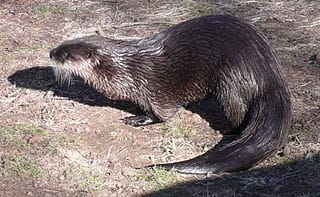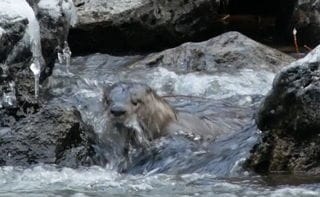This guide initially displays all common mammals. Use the selectors below to view mammals of a particular shape, include rare mammals, or search for them by name.
Mammals are defined as warm-blooded vertebrates with hair or fur and sweat glands — in the females mammary glands, modified sweat glands, produce milk to nourish the young. Most mammals develop a placenta which enables the feeding of the fetus during gestation and give birth to live young. In addition, although most mammals walk on land, many have specific adaptations that allow them to swim, fly, leap between tree branches or even dig extensive tunnels. Many wild mammals are used for both food and fur. while other have been domesticated for their agricultural and scientific importance.
New Mexico ranks high for mammalian diversity in the states in the US and the Pajarito Plateau is home to many of these species. This guide describes all of the larger wildlife found in the area as well as the more common smaller animals with the most abundant being rodents. Local species range from carnivores like the mountain lion and bobcat to ruminants like elk and deer to to several varieties of bats.
Mammal References
Biota Information System of New Mexico
Bogen et al. 1998 Continued Studies of Bat Species of Concern in the Jemez Mountains, New Mexico [PDF]
eNature
Frey et al. 2006 Checklist of New Mexico Mammals [PDF]
New Mexico Tech Mammalian Field Guide
Smithsonian National Museum of Natural History North American Mammals
Threatened, Endangered and Sensitive Species Profile – Los Alamos Laboratory Lands [PDF]
Tyrell and Brack 1992 Survey for Bats in the Los Alamos National Environmental Research Park
Subject Area Experts (all guides)
Steve Cary (butterflies)
Beth Cortright (insects)
Terry Foxx (invasive plants)
Leslie Hansen (mammals)
Richard Hansen (fish, mammals)
Dorothy Hoard (butterflies, trees)
Chick Keller (flowers, herbarium)
Shari Kelley (geology)
Kirt Kempter (geology)
Garth Tietjen (reptiles)
David Yeamans (birds)
Web Development and Content Management
Pat Bacha
Jennifer Macke
Graham Mark
Akkana Peck
Contact
Please contact us for local nature questions and sightings. We welcome comments, corrections, and additions to our guides.
For more information about local nature, please visit our Nature Blog or subscribe to PEEC This Week.
Make Selection
 Photo: Tim Vickers  Photo: Mitch Chapman |  Northern River Otter, North American River Otter, Common Otter(Lontra canadensis, Lutra canadensis)Family: Mustelidae (Weasels, Badgers, and Otters) Size: 35 - 52 in (89 - 132 cm) Status: native; rare Habitat: along waterways in wooded areas Typical location: Rio Grande, Valle Caldera, White Rock Canyon The Northern River Otter is essentially a semi-aquatic weasel. It is active by day and is well adapted to life both on land and in the water. It has a long tapered tail and webbed feet. Its thick, dark water-repellent pelt had been valued in the fur trade. It primarily hunts fish and crustaceans. The Northern River Otter lives in a burrow with multiple entrances close to the edge of a body of water. Slides made of mud or snow are the most obvious and well-known evidence of otters. They are known for their sense of play, wrestling among themselves and chasing each other. Otters were reintroduced to the Rio Grande River in 2008. One of these now local otters is pictured in the lower photo. Tracks Info Photos Distribution |
